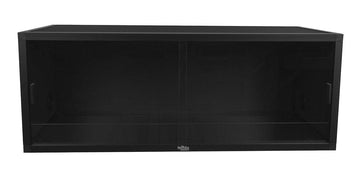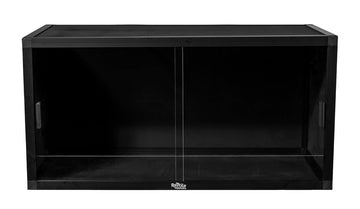The electric blue gecko is a tiny, 2.5-3.5” long, diurnal, arboreal lizard native to Tanzania. They are bound to a very limited range of forest, living on one particular species of Pandanus palm tree.
Electric blue geckos have stout bodies with a short pointy snout, large feet with sticky toe pads, and a plump tapered tail. True to their common name, male electric blue geckos demonstrate vibrant blue coloring with an orange underside and feet. Submissive males and females are more drab, their coloring a mixture of earthy green, orange, and sometimes blue. All have black striping on their heads.
Electric blue geckos are critically endangered in the wild, and somewhat hard to find in captivity because captive-bred individuals are in high demand. Their size and husbandry considerations make them intermediate-level pet reptiles.
Minimum terrarium size for electric blue geckos
The absolute minimum terrarium size for a single electric blue gecko is 12”L x 12”W x 18”H. Of course, larger (particularly wider) is always better! Electric blue geckos can be escape artists due to their tiny size, so make sure to seal up every nook and cranny!
Electric blue geckos tend to get along well when housed together, but unless you want to breed them, it’s best to house either just one male or multiple females together. Do not breed electric blue geckos unless you are fully prepared to accommodate the babies. Breeding is a serious project that should not be attempted casually.
Do electric blue geckos need UVB?
Yes! Electric blue geckos require UVB lighting for their survival. UVB lighting helps provide a clear day/night cycle, provides all of the vitamin D that your pet needs, supports the immune system, facilitates better digestion, and provides other benefits.
The best UVB bulbs for electric blue geckos are:
- Zoo Med T8 Reptisun 10.0, 24” — 4” above basking branch
- Arcadia ShadeDweller Kit — 6” above basking branch
For best results, house the UVB bulbs in a reflective fixture, roughly the same length as the enclosure. Position the lamp on the same side of the terrarium as the heat lamp. UVB is blocked by glass and plastic, so placing the terrarium in front of a window doesn’t count as “free UVB” — in fact it can make your terrarium too hot due to the greenhouse effect. Don’t forget to replace your bulb every 6 months!
Electric blue geckos benefit from plant grow lights as part of their environment as well. Add a ~6500K LED or T5 HO fluorescent grow lamp to provide extra illumination, as well as help any live plants in the terrarium to thrive.This extra illumination will encourage your gecko to be more active and show off its best colors!
Lights should be on for 12 hours/day.
Best temperature for electric blue geckos
Electric blue geckos should have a basking temperature of 90-95°F, as measured by a digital probe thermometer with the probe secured to the basking branch. General ambient temperatures should range between 75-80°F. Nighttime temps can drop as low as 65°F.
Provide heat for your gecko with a very low wattage heat bulb such as a halogen puck light or incandescent reptile bulb. Do not use a CHE or colored bulb, as these are not as effective.
Best humidity levels for electric blue geckos
Electric blue geckos are a tropical species, so the humidity inside their enclosure should be fairly high: 60-80% on average. Humidity should be measured via digital probe hygrometer, with the probe placed in the middle of the terrarium.
Increase humidity by misting your gecko’s enclosure 1-2x/day with a spray bottle. Mist first thing in the morning and then again at night if needed. Aside from raising humidity, this also provides your gecko with an important source of drinking water!
Best substrate for electric blue geckos
Providing a layer of naturalistic substrate (“bedding”) will help maintain correct humidity levels and also helps make your enclosure more attractive! We recommend the following substrates for electric blue geckos:
Layering clean, chemical-free leaf litter on top of the substrate can also help with humidity.
Substrate should be at least 2” deep and completely replaced every 3-4 months. Remove poop and urates daily, along with contaminated substrate. For ease of terrarium maintenance, you may wish to consider a bioactive setup.
How to decorate an electric blue gecko terrarium
An empty terrarium makes for a bored gecko, reducing its quality of life. Keep your pet entertained and engaged with its environment with the strategic use of décor items that encourage it to exercise natural behaviors!
Since electric blue geckos are arboreal, at bare minimum you will need a branch for your gecko to bask on and some live or artificial foliage for it to hide in. However, it’s best to include other items, such as:
- branches
- vines
- ledges
- live or artificial plants
What to feed to an electric blue gecko
Electric blue geckos are insectivores, which means that they need to eat both plant- and animal-based foods to get the right nutrition. How often electric blue geckos need to eat depends on age:
- Hatchlings and Juveniles — insects daily, CGD daily
- Adults — insects 2-3x/week, CGD 1x/week
Feeder insects for electric blue geckos: dubia roach nymphs, discoid roach nymphs, small crickets, small hornworms, small silkworms, fruit flies, bean beetles, isopods, springtails
Best crested gecko diets: Pangea, Repashy, Leapin’ Leachie, Zoo Med, Lugarti, Black Panther Zoological, Gecko Pro
The key to balanced nutrition is variety, so make sure to offer a rotation of as many different foods as possible. Feeder insects should be 1/4" long or less.
Supplements
You will also need a calcium supplement. We recommend Repashy Supercal NoD, lightly dusted on all feeder insects. It’s okay to occasionally skip a dusting.
Water
Of course, don’t forget small food and water bowls and a feeding ledge! Since electric blue geckos are arboreal, they prefer to eat and drink up off the ground. Change the water daily and scrub the bowl with a reptile-safe disinfectant weekly, or whenever it becomes soiled.
How to handle your electric blue gecko
Electric blue geckos are very small and very fast, so it’s best not to try handling your gecko. If you want to interact with your pet, try hand-feeding it with a pair of feeding tweezers instead.
*This care sheet contains only very basic information. Although it’s a good introduction, please further your research with high-quality sources. The more you know, the better you will be able to care for your pet!
"Blauer Zwergtaggecko (Lygodactylus williamsi)" by to.wi is licensed under CC BY-NC-SA 2.0











